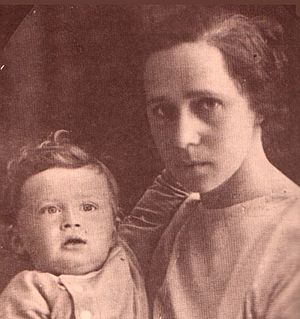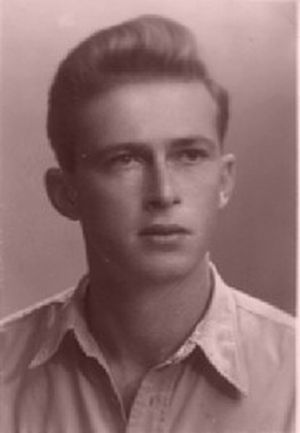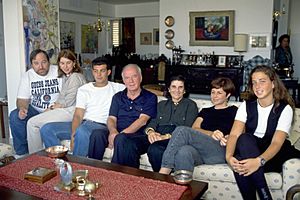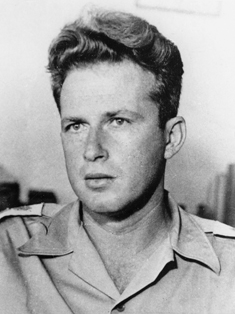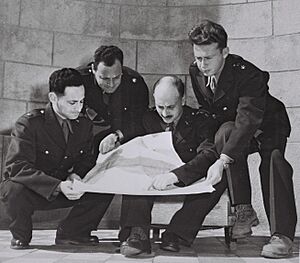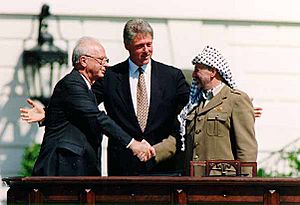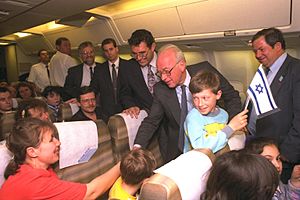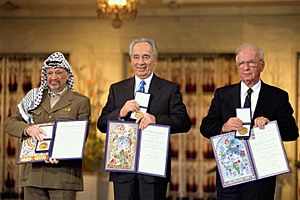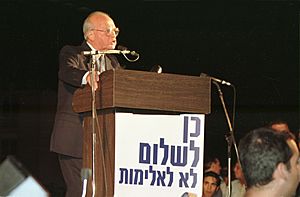Yitzhak Rabin facts for kids
Quick facts for kids
Yitzhak Rabin
|
|
|---|---|

Rabin in 1994
|
|
| 5th Prime Minister of Israel | |
| In office 13 July 1992 – 4 November 1995 |
|
| President | |
| Preceded by | Yitzhak Shamir |
| Succeeded by | Shimon Peres |
| In office 3 June 1974 – 20 June 1977 |
|
| President | Ephraim Katzir |
| Preceded by | Golda Meir |
| Succeeded by | Shimon Peres (acting) |
| Member of the Knesset | |
| In office 1974 – 4 November 1995 |
|
| Ambassador of Israel to the United States | |
| In office 1968–1973 |
|
| Prime Minister | Levi Eshkol Yigal Allon (acting) Golda Meir |
| Preceded by | Avraham Harman |
| Succeeded by | Simcha Dinitz |
| Ministerial roles | |
| 1974 | Minister of Labor |
| 1974–1975 | Minister of Communications |
| 1975 | Minister of Welfare |
| 1984–1990 | Minister of Defense |
| 1992–1995 | Minister of Defense |
| 1992 | Minister of Labor and Social Welfare |
| 1992 | Minister of Jerusalem Affairs |
| 1992–1995 | Minister of Religious Affairs |
| 1993 | Minister of Education and Culture |
| 1993–1995 | Minister of Internal Affairs |
| 1994 | Minister of Health |
| Personal details | |
| Born | 1 March 1922 Jerusalem, Mandatory Palestine |
| Died | 4 November 1995 (aged 73) Tel Aviv, Israel |
| Cause of death | Assassination |
| Nationality | Israeli |
| Political party | Alignment, Labor Party |
| Spouse |
Leah Rabin
(m. 1948) |
| Children |
|
| Profession | Military officer |
| Signature |  |
| Military service | |
| Allegiance | Israel |
| Branch/service | Haganah Israeli Defense Forces |
| Years of service | 1941–1967 |
| Rank | Rav Aluf |
| Battles/wars | Syria–Lebanon Campaign Jewish insurgency in Mandatory Palestine 1948 Arab–Israeli War Six-Day War |
Yitzhak Rabin (born March 1, 1922 – died November 4, 1995) was an important Israeli leader. He was a soldier and a politician. He served as the Prime Minister of Israel two times. His first term was from 1974 to 1977, and his second was from 1992 until he was sadly killed in 1995.
Rabin was born in Jerusalem. His parents were Jewish immigrants from Eastern Europe. He grew up in a family that believed in Labor Zionism, which combined workers' rights with building a Jewish homeland. He studied agriculture and was a very good student. He spent 27 years as a soldier and became a top general.
As a teenager, he joined the Palmach, a special commando group. He became its chief of operations during the 1948 Arab–Israeli War. After the war, he joined the new Israel Defense Forces (IDF). He helped train soldiers and led important operations. In 1964, he became the Chief of the General Staff of the IDF. He led Israel to victory in the 1967 Six-Day War.
After his military career, Rabin was Israel's ambassador to the United States from 1968 to 1973. This was a time when the relationship between the U.S. and Israel grew much stronger. In 1974, he became Prime Minister. During his first term, he signed an important agreement with Egypt. He also ordered the famous Entebbe raid, where Israeli soldiers rescued hijacked passengers in Uganda. He resigned in 1977.
Rabin served as Israel's Minister of Defense for many years in the 1980s. In 1992, he was elected Prime Minister again. He worked hard for peace between Israelis and Palestinians. He signed the historic Oslo Accords with Palestinian leaders. In 1994, he won the Nobel Peace Prize with Shimon Peres and Yasser Arafat. He also signed a peace treaty with Jordan in 1994.
In November 1995, Yitzhak Rabin was killed by an extremist who did not agree with the peace agreements. He was the first Israeli Prime Minister born in Israel. He was also the only Prime Minister to be killed while in office. Today, Rabin is seen as a symbol of the effort for peace between Israelis and Palestinians.
Contents
- Early Life and Family
- Marriage and Family Life
- Military Career
- Ambassador to the United States (1968–1973)
- First Term as Prime Minister (1974–1977)
- Minister of Defense (1984–1990)
- Second Term as Prime Minister (1992–1995)
- Assassination and Legacy
- Images for kids
- Remembering Yitzhak Rabin
- Roles Yitzhak Rabin Held
- Awards and Decorations
- Published Works
- See Also
Early Life and Family
Rabin's Family Background
Yitzhak Rabin was born in Jerusalem on March 1, 1922. His parents, Nehemiah and Rosa Rabin, had moved to Palestine from Europe. His father, Nehemiah, was born in Ukraine. He moved to the United States when he was 18. Later, he came to Palestine as a volunteer with the Jewish Legion.
Yitzhak's mother, Rosa Cohen, was born in Belarus. Her father was a rabbi. Rosa was interested in politics and social issues. She came to Palestine in 1919. She worked on a kibbutz (a community farm) before moving to Jerusalem.
Rabin's parents met in Jerusalem in 1920. They moved to Tel Aviv in 1923. His father worked for the Palestine Electric Corporation. His mother was an accountant and a local activist. She even became a member of the Tel Aviv City Council.
Growing Up and School
Yitzhak Rabin grew up in Tel Aviv. He started school in 1928. The school taught children about farming and Zionism, which is the movement to create and support a Jewish homeland. Rabin was a good student, but he was very shy.
In 1935, Rabin went to an agricultural school that his mother helped start. Here, at age 14, he joined the Haganah. This was a Jewish defense organization. He learned how to use a pistol and stand guard. He also joined a youth movement called HaNoar HaOved.
In 1937, he went to the Kadoorie Agricultural High School. He was good at farming subjects. However, he did not like studying English. His interest in military matters grew in 1938. This was because of the ongoing Arab revolt in Palestine. A young Haganah sergeant, Yigal Allon, trained Rabin at Kadoorie. Rabin finished school in 1940. He thought about studying engineering in the U.S. but decided to stay and fight in Palestine.
Marriage and Family Life
Rabin married Leah Schlossberg during the 1948 Arab–Israeli War. Leah was a reporter for a Palmach newspaper. They had two children: a daughter named Dalia (born 1950) and a son named Yuval (born 1955). Rabin was not religious. He saw his Jewish identity as part of his Israeli nationality.
Military Career
Joining the Palmach
In 1941, Rabin joined the Palmach. This was a special unit of the Haganah. His first mission was to help the allied forces invade Lebanon in 1941. During this time, the Palmach operated secretly to avoid the British authorities. They spent time farming and training in secret.
In 1943, Rabin became a platoon commander. He taught his men modern fighting tactics. In 1945, Rabin planned a Palmach raid. They freed 208 Jewish immigrants who were held in a camp. Later, Rabin was arrested by the British. He was held for five months. After his release, he became a battalion commander. In October 1947, he became the Chief Operations Officer of the Palmach.
Service in the IDF
During the 1948 Arab–Israeli War, Rabin led Israeli operations in Jerusalem. He also fought the Egyptian army. He commanded the Harel Brigade. This brigade fought to open the road to Jerusalem. They also fought battles in Jerusalem itself.
Later, Rabin was a deputy commander in a large operation called Operation Danny. This operation captured the cities of Ramle and Lydda. After the war, Rabin was a member of the Israeli team that negotiated peace agreements with Egypt in 1949. These agreements officially ended the fighting of the 1948 war.
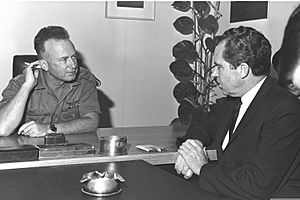
From 1956 to 1959, Rabin led Israel's Northern Command. In 1964, he became the Chief of Staff of the Israel Defense Forces (IDF). He was chosen by Prime Minister Levi Eshkol. Under Rabin's command, the IDF won a major victory in the Six-Day War in 1967. After Jerusalem's Old City was captured, Rabin was among the first to visit it. He gave a famous speech there.
Ambassador to the United States (1968–1973)
After leaving the IDF, Rabin became Israel's ambassador to the United States. He served in this role for five years, starting in 1968. During this time, the U.S. became Israel's main supplier of weapons. Rabin helped ensure Israel received important fighter jets. He did not hold an official position during the 1973 Yom Kippur War.
First Term as Prime Minister (1974–1977)
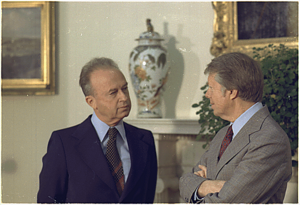
In 1974, Rabin became the leader of the Labor Party. He then became the Prime Minister of Israel on June 3, 1974. This was a coalition government, meaning it included several political parties.
A major event during his first term was the Sinai Interim Agreement. This was signed between Israel and Egypt in 1975. Both countries agreed to try to solve their conflict peacefully. This agreement was an important step towards future peace treaties.
Another famous event was Operation Entebbe. In 1976, Rabin ordered the IDF to rescue passengers from a hijacked airplane in Uganda. The operation was a great success. It is still studied today as an example of a daring rescue mission.
Rabin resigned in 1977.
Minister of Defense (1984–1990)
From 1984 to 1990, Rabin served as Minister of Defense. During this time, Israeli troops were in Lebanon. Rabin ordered them to withdraw to a "Security Zone" near the border.
When the first Intifada (a Palestinian uprising) began, Rabin used strong measures to stop the violence. However, he later realized that negotiation was needed. He began to seek a way to end the conflict through talks.
Second Term as Prime Minister (1992–1995)
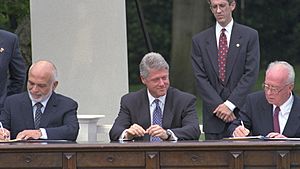
In 1992, Rabin was elected leader of the Labor Party again. He then led his party to victory in the national elections. He became Prime Minister for a second time. His government focused on peace with the Palestinians.
Rabin played a key role in signing the Oslo Accords. These agreements created the Palestinian National Authority. This authority was given some control over parts of the Gaza Strip and West Bank. Before the signing, Palestinian leader Yasser Arafat recognized Israel. Rabin then officially recognized the PLO.
After shaking hands with Yasser Arafat, Rabin said, "Enough of blood and tears. Enough!" During this term, Rabin also signed a peace treaty with Jordan in 1994.
Economic and Social Changes
Rabin also made big changes to Israel's economy, education, and healthcare. His government allowed more private businesses. This moved Israel away from its traditional socialist economy. In 1993, a program called "Yozma" was started. It offered tax benefits to foreign companies that invested in Israel's high-tech industry. This helped Israel's economy grow.
In 1995, a new law created Israel's universal health care system. This meant everyone had health insurance. Education spending also increased. New colleges were built, and teachers' salaries went up. His government also started new public projects, like a major highway and airport expansion.
Nobel Peace Prize
For his work on the Oslo Accords, Rabin received the 1994 Nobel Peace Prize. He shared it with Yasser Arafat and Shimon Peres. The Accords caused a lot of debate in Israel. Some people saw Rabin as a hero for peace. Others saw him as giving away land that belonged to Israel.
Assassination and Legacy
On November 4, 1995, Yitzhak Rabin was killed. He was at a large peace rally in Tel Aviv. A right-wing extremist named Yigal Amir shot him. Rabin was taken to the hospital but died during surgery. Amir was arrested and sentenced to life in prison.
Rabin's death shocked Israel and the world. Many thousands of Israelis came to mourn him. Young people lit candles and sang peace songs. On November 6, 1995, he was buried on Mount Herzl. Many world leaders attended his funeral, including U.S. President Bill Clinton. Clinton ended his speech with the Hebrew words "Shalom, Haver," meaning "Goodbye, Friend."
The square where he was killed was renamed Rabin Square in his honor. Many other places in Israel are also named after him. After his death, Rabin became a symbol of peace efforts in Israel. In 2000, his wife Leah died and was buried next to him.
Rabin's daughter, Dalia Rabin-Pelossof, later became a politician. She was elected to the Knesset in 1999. In 2001, she served as Israel's deputy Minister of Defense.
Images for kids
-
Graves of Yitzhak (right) and Leah Rabin (left) on Mount Herzl
Remembering Yitzhak Rabin
- The Knesset (Israel's parliament) chose the 12th of Cheshvan as Rabin's official memorial day. This is the date of his murder according to the Hebrew calendar.
- In 1995, the Israeli Postal Authority released a special stamp to remember Rabin.
- In 1996, a famous Israeli songwriter, Naomi Shemer, wrote music for a Hebrew translation of the poem "O Captain! My Captain!" to honor Rabin. This song is often performed on his memorial day.
- The Yitzhak Rabin Centre was created in 1997. It works to keep Rabin's memory alive. It also teaches about democracy and peace.
- Many cities in Israel have named streets, schools, and parks after Rabin. Large power stations and government buildings also carry his name. Outside Israel, there are streets and parks named after him in cities like Bonn, Berlin, Chicago, and Paris.
Roles Yitzhak Rabin Held
Rabin served as Prime Minister of Israel two times. His first term was from 1974 to 1977. His second term was from 1992 until he was killed in 1995. He was also a member of the Knesset (Israel's parliament) from 1974 until his death. Before becoming Prime Minister, he was Israel's ambassador to the United States from 1968 to 1973.
Labor Party Leadership
Rabin was the leader of the Israeli Labor Party twice.
| Time Period | Who was leader before him? | Who was leader after him? | National elections as leader | When was he elected/re-elected? |
|---|---|---|---|---|
| April 1974–February 1977 | Golda Meir | Shimon Peres | 1974, 1977 (Feb) | |
| February 1992–November 4, 1995 | Shimon Peres | Shimon Peres | 1992 | 1992 |
Ministerial Positions
| Job Title | Time Period | Prime Minister(s) | Government(s) | Who had the job before him? | Who had the job after him? |
|---|---|---|---|---|---|
| Minister of Labor | March 10, 1974–June 3, 1974 | Golda Meir | 16th | Yosef Almogi | Moshe Baram |
| Minister of Communications | June 3, 1974–March 20, 1975 | Yitzhak Rabin | 17th | Aharon Uzan | Aharon Uzan |
| Minister of Welfare | July 7, 1975–July 29, 1975 | Yitzhak Rabin | 17th | Michael Hasani | Yosef Burg |
| Minister of Defense (first time) | September 13, 1984–March 20, 1990 | Shimon Peres (until 1986) Yitzhak Shamir (after 1986) |
21st, 22nd, 23rd | Moshe Arens | Yitzhak Shamir |
| Minister of Defense (second time) | July 13, 1992–November 4, 1995 | Yitzhak Rabin | 25th | Moshe Arens | Shimon Peres |
| Minister of Labor and Social Welfare | July 13, 1992–December 31, 1992 | Yitzhak Rabin | 25th | Yitzhak Shamir | Ora Namir |
| Minister of Jerusalem Affairs | July 13, 1992–December 31, 1992 | Yitzhak Rabin | 25th | Yitzhak Shamir | Eli Suissa |
| Minister of Religious Affairs | July 13, 1992–February 27, 1995 | Yitzhak Rabin | 25th | Avner Shaki | Shimon Shetreet |
| Minister of Education and Culture | May 11, 1993–June 7, 1993 | Yitzhak Rabin | 25th | Shulamit Aloni | Amnon Rubinstein |
| Minister of Internal Affairs (first time) | May 11, 1993–June 7, 1993 | Yitzhak Rabin | 25th | Aryeh Deri | Aryeh Deri |
| Minister of Internal Affairs (second time) | September 14, 1993–February 27, 1995 | Yitzhak Rabin | 25th | Aryeh Deri | Uzi Baram |
| Minister of Health | February 8, 1994–June 1, 1994 | Yitzhak Rabin | 25th | Haim Ramon | Efraim Sneh |
Awards and Decorations
| War of Independence Ribbon | Operation Kadesh Ribbon | Six-Day War Ribbon |
Published Works
- Rabin, Yitzhak (17 November 1996). The Rabin Memoirs. University of California Press. ISBN 0-520-20766-1.
See Also
 In Spanish: Isaac Rabin para niños
In Spanish: Isaac Rabin para niños
- List of Israeli Nobel laureates
- List of Jewish Nobel laureates
- Shir LaShalom, the "Peace Song" sung by Rabin at the peace rally shortly before his assassination


